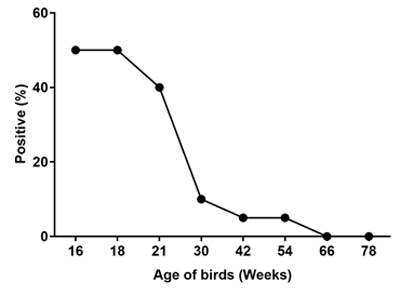Development of an effective vaccination protocol to produce Salmonella-free layer flock
Authors: Taslima Akter, Mohammed Nooruzzaman, Tanjin Tamanna Mumu, Mustak Ahammed, ABM Jalal Uddin, Rokshana Parvin, Md. Abu Hadi Noor Ali Khan and Md. Mokbul Hossain
GMPC TOP
2021.
vol. 2, Iss. 1
pp:1-6
Doi: https://doi.org/10.51585/gtop.2021.2.0006

Abstract:
Salmonella infections are of prime importance in the layer chicken industry and pose a significant public health threat. Production of export quality poultry products requires Salmonella-free certification. We developed and applied a vaccination schedule based on a commercial live attenuated Salmonella enterica serovar Gallinarum biovar Gallinarum (S. Gallinarum) vaccine in a layer flock. A flock of 1000 ISA Brown chickens has been vaccinated with a lyophilized fowl typhoid live vaccine at definite time intervals. Isolation of Salmonella spp. in cloacal swabs and detection of serum antibody responses were performed using serum plate agglutination (SPA) test and ELISA. At the time of vaccination (16 weeks (w) of age), 50% of the tested birds carried Salmonella spp. in feces. Following booster immunization at 18 w, 21 w, and then every 12 weeks interval, the shedding of Salmonella decreased significantly over time with 40% at 21 w, 10% at 30 w, and 5% each at 42 and 54 w, and no shedding was detected at 66 and 78 w. Biochemical analysis of 32 Salmonella isolates revealed 15.6% (n=5) Salmonella enterica serovar Gallinarum biovar Pullorum (S. Pullorum), 37.5% (n=12) Salmonella Gallinarum, and 46.9% (n=15) paratyphoid causing Salmonella. Of note, the Salmonella spp. detected after 21 w of age belonged to the paratyphoid group. The decreased shedding of bacteria paralleled with increased antibody responses. The antibody level at vaccination (20% positive rate at 16 w) increased over time with a 50% positive rate at 18 w, 80% at 42 w, 90% at 54 w, and 100% at 66 w and 78 w by serum plate agglutination (SPA) test. Similarly, the serum antibody levels of chickens were also measured using ELISA and were similar to the SPA test. In conclusion, the vaccine schedule developed in this study confirmed a high seroconversion and prevented Salmonella shedding in feces. Therefore, a three-month interval vaccination protocol from the pre-laying stage to the last stage of laying is recommended to prevent Salmonella infections in laying flocks.
Keywords:
Salmonella infection, Vaccination, SPA, ELISA, Poultry, Bangladesh
Statistics:
Article Views: 2276
PDF Download: 28